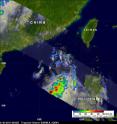NASA sees heavy rainfall in Tropical Storm Sarika
Tropical Depression 05W has grown into a tropical storm and given the name Sarika as it heads toward China. Satellite imagery from NASA shows that the center of the storm seems to be separated from the strongest thunderstorms. The Tropical Rainfall Measuring Mission (TRMM) satellite that is co-managed by NASA and the Japanese Space Agency measures rainfall in the tropics, and today's satellite imagery (June 10, 2011) on Tropical Storm Sarika shows that the heaviest rainfall (falling at 2 inches/50 mm per hour) is south of the center of the storm's circulation. That's an indication that the storm will not intensify. Normally in intensifying storms the heaviest rainfall is around the center of circulation. TRMM imagery is created at NASA's Goddard Space Flight Center in Greenbelt, Md.
In addition, infrared satellite imagery revealed that the low-level circulation center is now fully exposed, which allows outside winds inside to weaken the circulation of the storm. As the system continues to track north, it is expected to run into stronger wind shear, which is expected to keep the storm from strengthening.
Regardless of intensification, Tropical Storm Sarika is in the South China Sea and charting a course for Hong Kong and China and both have posted warnings. Hong Kong posted a "Stand-by Signal 1" across the territory.
Although Sarika didn't intensify into a cyclone until today, it brought heavy rainfall and flooding in the northwestern Philippines. A weather observer named Adonis was in contact with NASA's Hurricane web page and noted that five people were reported killed from rapidly rising flood waters in Central Luzon. He noted that intermittent rainfall fell in Iloilo and Guimaras Island last night as the system pulled away to the north.
At 1500 UTC (11 a.m. EDT) Tropical Storm Sarika had maximum sustained winds near 35 knots (39 mph). It was located about 160 nautical miles east-southeast of Hong Kong, China near 21.9 North and 116.9 East. Sarika is moving north at 14 knots.
Sarika is forecast to intensify before making landfall and dissipate east of Hong Kong over the weekend.
Source: NASA/Goddard Space Flight Center
Articles on the same topic
- NASA catches system 92W become fifth NW Pacific tropical depressionThu, 9 Jun 2011, 20:37:02 UTC
- NASA's infrared image of major Hurricane Adrian reveals its stormy life's bloodThu, 9 Jun 2011, 20:36:48 UTC
- A double-satellite NASA-style view of the first tropical storm in eastern Pacific: AdrianWed, 8 Jun 2011, 21:02:46 UTC
- NASA sees a hot tower in first tropical depression of the eastern PacificTue, 7 Jun 2011, 21:02:49 UTC
- Possible first eastern Pacific tropical depression shaping up on NASA imageryTue, 7 Jun 2011, 18:35:52 UTC
Other sources
- NASA sees heavy rainfall in Tropical Storm Sarikafrom PhysorgFri, 10 Jun 2011, 19:00:28 UTC
- NASA's infrared image of major Hurricane Adrian reveals its stormy life's bloodfrom PhysorgThu, 9 Jun 2011, 21:00:46 UTC
- NASA catches system 92W become fifth NW Pacific tropical depressionfrom PhysorgThu, 9 Jun 2011, 20:31:14 UTC
- A double-satellite NASA-style view of the first tropical storm in eastern Pacific: Adrianfrom PhysorgWed, 8 Jun 2011, 22:00:25 UTC
- Season's first tropical depression formsfrom UPIWed, 8 Jun 2011, 3:30:35 UTC
- Season's first tropical depression formsfrom UPIWed, 8 Jun 2011, 0:00:20 UTC
- NASA sees a hot tower in first tropical depression of the eastern Pacificfrom PhysorgTue, 7 Jun 2011, 21:30:55 UTC
- First Hurricane Of Season Forms In Pacificfrom CBSNews - ScienceTue, 7 Jun 2011, 20:31:29 UTC
- Satellite spots potential Pacific stormfrom UPITue, 7 Jun 2011, 18:30:31 UTC
- Satellite spots potential Pacific stormfrom UPIMon, 6 Jun 2011, 22:00:12 UTC
- Possible first eastern Pacific tropical depression shaping up on NASA imageryfrom PhysorgMon, 6 Jun 2011, 21:30:35 UTC
